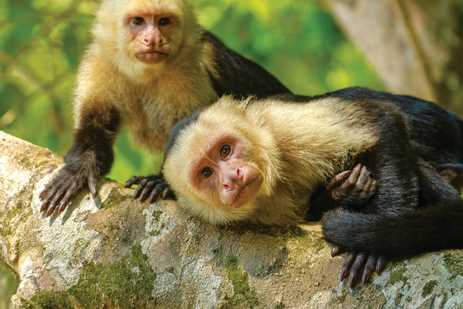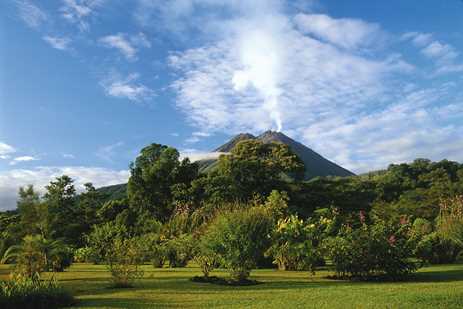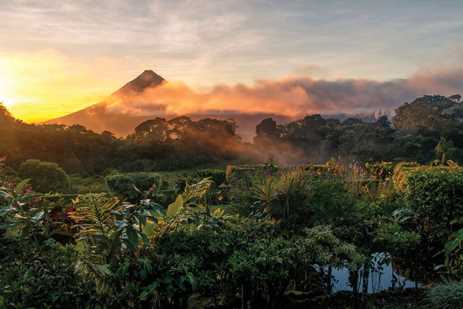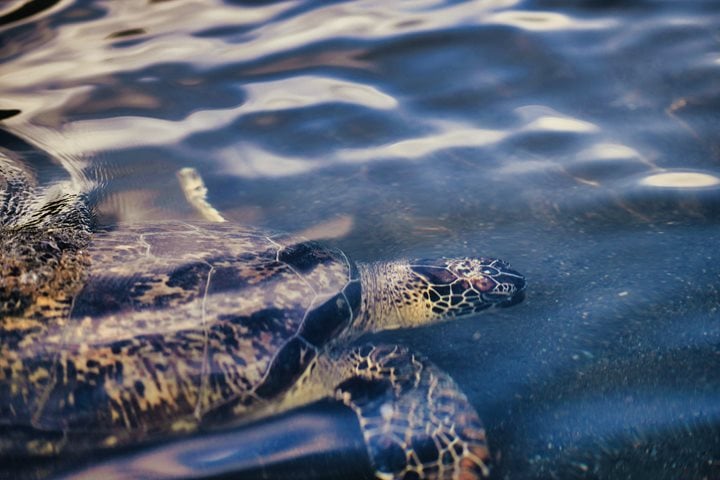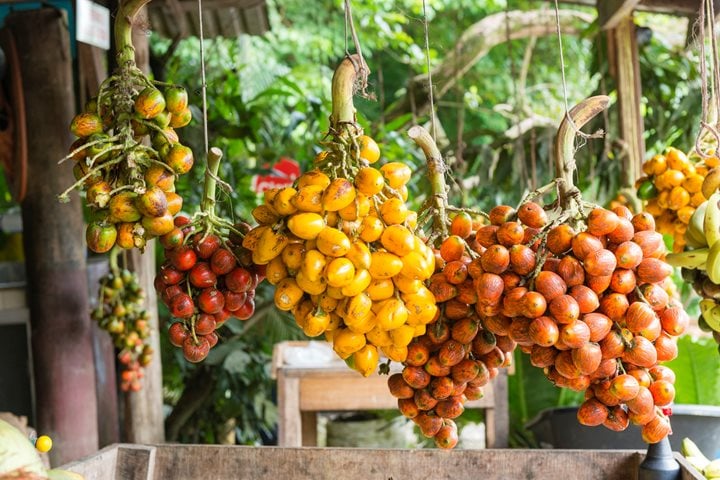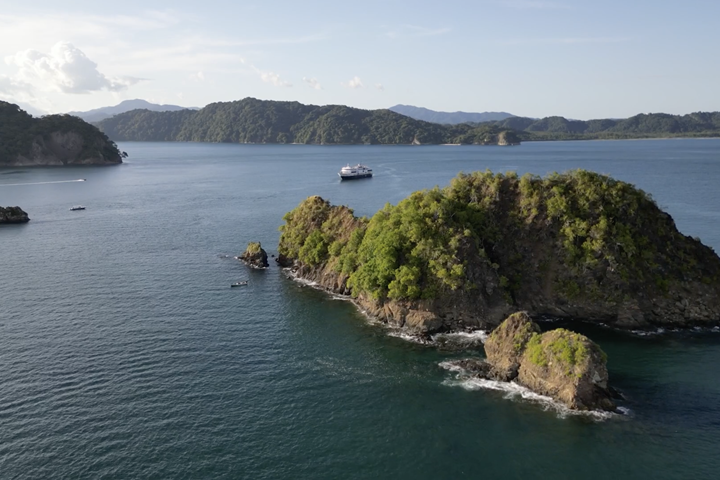There are certain destinations that stop even the most serious birder in their tracks. Costa Rica is absolutely one of those places, with seemingly endless bird watching opportunities guaranteed to delight any traveler.
From toucans to tanagers and hummingbirds to herons, more than 900 species of Costa Rica birds can be found thriving throughout the country’s lush and diverse habitats. Costa Rica bird watching tours, like the ones offered on itineraries with National Geographic-Lindblad Expeditions, will help maximize your chances of spotting as many amazing, feathered friends as possible.
Ahead, discover some of the best places for bird watching in Costa Rica along with what makes each a stand-out destination you won’t want to miss.
Costa Rica Birding Highlights
- Arenal Volcano National Park: Keel-billed Toucans, Montezuma Oropendola, Collared Aracari, Black-crested Coquette
- Corcovado National Park: Great Curassow, Black-cheeked Ant-Tanager, Baird’s Trogon
- Golfo Dulce Forest Reserve: Red-billed Tropicbird, Yellow-billed Cotinga, Mangrove Hummingbird
- Rincón de la Vieja National Park: White-throated Magpie-Jay, Ferruginous Pygmy Owl, Yellow-naped Amazon, Turquoise-browed Motmot
- Curú National Wildlife Refuge: Long-tailed Manakin, Rufous-backed Wren, Orange-fronted Parakeet
- Caño Negro Wildlife Refuge: Nicaraguan Grackle, Agami Heron, Black-collared Hawk
- Palo Verde National Park: Roseate Spoonbill, White Ibis, Black-crowned Night-Heron, Blue-winged Teal
- Monteverde Cloud Forest: Resplendent Quetzals, Three-wattled Bellbird, Orange-bellied Trogon, and 400+ other species
- Sirena Biological Station: Great Curassow, Scarlet Macaw, Yellow-billed Cotinga
- Tortuguero National Park: Green Ibis, Agami Heron, Great Green Macaw
- Carara National Park: Scarlet Macaws, Royal Flycatcher, Black-hooded Antshrike
- La Selva Biological Station: 400+ bird species, including Great Green Macaws and Keel-billed Toucans
- Las Cruces & Wilson Botanical Garden: Violet Sabrewing, Broad-billed Motmot, Blue-gray Tanager
How to Choose the Right Costa Rica Birding Tour
To start, consider your goals for bird watching in Costa Rica: Are you hoping to sleuth out one spectacular target bird, or max out your life list? If it’s the Resplendent Quetzal you’re after, then, Monteverde is the place to be. If you’re a completist hoping to spot every toucan species in the country, Corcovado National Park might be your best bet.
If you can’t rest until you’ve snapped a National Geographic-worthy action shot of a Harpy Eagle, a photo tour—or at least a guide who knows their way around a Nikon—will ensure you go home happy.
“Costa Rica is a very small country, so it’s easy to move from one ecosystem to another,” explains Costa Rican naturalist and expert birder Federico Chacón, who’s been working with National Geographic-Lindblad Expeditions for over 25 years.
“It’s one of the most biologically diverse countries by size. Other countries may have more species, but you’d have to cover a lot more ground to see them.” That means that done right, this can be one of the most memorable birding adventures of your life—all you need to do is narrow down the birding trips that will deliver on your dreams.
Birding is a key component of Costa Rica voyages with National Geographic-Lindblad Expeditions. With a team of naturalists like Chacón, including ornithology pros who can identify avian behavior, you’ll venture to some of the country’s wildest corners—from serene golden beaches to thick mangrove forests aflutter with birdlife.
Best Places for Birdwatching in Costa Rica
It’s hard to go wrong birding in a country as richly biodiverse as Costa Rica, but there are endless ways to get your trip right. Ahead, find six top bird watching destinations you can visit on a National Geographic-Lindblad Expeditions voyage—followed by seven more standout stops worth adding to your travel to-do list.
Arenal Volcano National Park — Craters, Curassows, and Collared Aracaris
Towering over the eastern shore of Lake Arenal, the cone of Arenal Volcano makes for dramatic vistas when you emerge from the forest in this 30,000-acre national park.
Arenal’s dense jungle sits smack in the middle of key migratory pathways between North and South America, making it a vital habitat for birds in Costa Rica—nearly all of the 800-plus species found in the country can be seen within the bounds of this spectacular park.
“There are a lot of places in Arenal to do good birding,” says Chacón. “You can check off a lot of tanagers, a lot of the toucans, maybe even the Yellow-eared Toucanet—it’s in the region, but it's the hardest to see.”
Wander the trails that snake along the volcano’s slope for sightings of other forest species like the Rufous-tailed Hummingbird and Montezuma Oropendola, then head down to the peninsula trails for water birds such as the Great Egret and Neotropic Cormorant.
Why visit:
Marry volcano views, sweeping lake vistas, and incredible birding—plus high-octane adventures like ziplining and jungle hikes across remote suspension bridges
Bird Species at Arenal Volcano National Park:
- Montezuma Oropendola
- Keel-billed Toucan
- Collared Aracari
- Yellow-eared Toucanet
- Bare-necked Umbrellabird
- Great Curassow
- Rufous-tailed Hummingbird
- Crested Guan
- Thicket Antpitta
- Keel-billed Motmot
Corcovado National Park — Scarlet Macaw Central
Tucked into the elbow of the Osa Peninsula, Costa Rica’s most expansive national park boasts an astounding three percent of the world’s biodiversity. Spanning 164 square miles of tropical forest, sandy shoreline, brackish mangrove swamp and more, Corcovado’s many ecosystems play host to a whopping 367 bird species.
It’s among the most remote of Costa Rica’s national parks, says Chacón, so whether you’re glued to binoculars for a glimpse of a Scarlet Macaw’s Technicolor plumage or ticking off all six Costa Rican toucan species, you’re apt to have the hiking trails all to yourself.
Since it’s also home to big cats, tapirs, coatis, capuchin monkeys and hundreds of other mammals, it’ll be just as much of a hit with travel companions who have yet to catch the bird-watching bug.
Why visit:
Untrammeled jungle beckons, with a head-spinning variety of ecosystems and a diverse selection of birds to match
Bird Species at Corcovado National Park:
- Scarlet Macaws
- Orange-collared Manakin
- Great Curassow
- Baird’s Trogon
- Turquoise Cotinga
- Black-cheeked Ant Tanager
- Yellow-billed Cotinga
- Great Potoo
- Fiery-billed Aracari
Golfo Dulce Forest Reserve — Endangered Species Amid the Mangroves
The first moments in Golfo Dulce Forest Reserve feel like a spell has been cast, as sunlight filters through the overstory and gives the forest an otherworldly glow. Ancient ceiba trees disappear into the canopy, mangroves stand on tangled roots over brackish water, and moss and epiphytes cling to every surface—this is a place exploding with life, and the birds are no exception.
“Golfo Dulce is one of only four tropical fjords in the world, and it's a unique ecosystem,” says National Geographic-Lindblad Expeditions naturalist Margrit Ulrich. There’s rivers and ocean, mangrove swamps and tropical rainforest all packed within its tiny footprint.
In and around the gulf, spot the usual marine and shorebird suspects, including frigatebirds, boobies and sandpipers. Roseate Spoonbills, anhingas and others flank the waterways as you move inland, and the trees harbor brightly colored rainforest species, including the iconic Scarlet Macaw. As you kayak under the arbor of mangroves, look for a glittering flash of blue-green—it's the endemic and endangered Mangrove Hummingbird.
Why visit:
This dramatic tropical fjord landscape is frequented by marine, freshwater and forest birds alike
Bird Species at Golfo Dulce Forest Reserve:
- Roseate Spoonbill
- Turquoise Cotinga
- Yellow-billed Cotinga
- Nazca Booby
- Red-billed Tropicbird
- Mangrove Hummingbird
- Gartered Trogon
- Scarlet Macaw
Rincón de la Vieja National Park — A Geothermal and Avian Hotspot
Exploring Guanacaste’s largest and most active volcano is such an action-packed experience you’d be forgiven for letting your life list fall by the wayside while you’re there. But if you’re up for slowing down a bit (or logging a few quick sightings on the wing), it’s as rich in avian life as you might expect, with more than 300 recorded species within the park.
“The nearly 2.5-mile-long loop trail offers great birding, with a chance to spot and photograph Long-tailed and Red-headed Manakins, woodcreepers and toucans,” says Chacón. Where dry forest and cloud forest collide, you can tally tens of birds seemingly at every step, including the delightfully goofy Northern Potoo.
While you’re scanning the trees, don’t forget to look around at ground level: The park’s swinging bridges, cerulean waterfalls, and bubbling mudpots are almost enough to make you forget about the birds.
Why visit:
Hard-to-spot species, postcard-worthy views, ziplining ops and dreamy jungle vignettes that will delight birders and non-birders alike
Bird Species at Rincón de la Vieja National Park:
- White-throated Magpie-Jay
- Lesser Ground Cuckoo
- Long-tailed Manakin
- Pacific Screech Owl
- Ferruginous Pygmy Owl
- Cinnamon Hummingbird
- Yellow-naped Amazon
- Turquoise-browed Motmot
- Northern Potoo
Curú National Wildlife Refuge — Motmots and Manakins at Water’s Edge
Situated at the edge of the southern Nicoya Peninsula, this privately owned expanse feels like a tropical dream sequence made real. Howler monkeys shout from the treetops, a wooden bridge leads across a croc-filled estuary, pumas prowl in shadowy corners, and just beyond the fringes of it all, an impossibly clear blue sea.
With 232 bird species on record, there’s always something to see in Curú, notably a thriving breeding population of Scarlet Macaws, reintroduced here in 1999. You’re also likely to catch the trademark blue back and scarlet crown of the Long-tailed Manakin and a kaleidoscopic array of colorful parrots and parakeets.
“Make sure you walk the entrance road in Curú,” says Ulrich. “It’s super flat with a nice cover of trees, but a bit more exposed so easier for spotting. People come back with the most incredible numbers of sightings—toucans, macaws, motmots. What could be better?!”
Why visit:
Hikes and strolls for every speed, plus a dizzying number of dry forest bird species to spot
Bird Species at Curú Wildlife Refuge:
- Long-tailed Manakin
- Rufous-backed Wren
- Turquoise-browed Motmot
- Yellow-naped Parrot
- Orange-fronted Parakeet
- Blue-crowned Motmot
Caño Negro Wildlife Refuge — Waterbirds and Natural Treasures in the Treetops
This dynamic refuge lies just shy of the Nicaraguan border, with braided streams and lagoons stretching into every corner. “Caño Negro is a water ecosystem and a Ramsar site, so it’s ideal for birding” says Chacón, referencing the region’s Ramsar Wetlands of International Importance designation.
“You’re moving up and down the river on boats, which gives great potential to see a lot of different birds and unique species like the Nicaraguan Grackle, which you won’t see anywhere else in Costa Rica,” he explains.
On the catchily named Río Frío, you’ll pass flocks of egrets, ibis and Northern Jacana by the dozen, and in the treetops you can spy parakeets, woodcreepers, toucans, and ten different species of woodpecker.
There’s also wildlife to watch, with caimans resting like statues on the riverbanks and capuchins swinging overhead. Newbie and veteran birders alike should look out for the striking, painterly plumage of the Agami Heron and that aforementioned grackle.
Why visit:
Where there is water, there’s unbeatable birding—and at this wetland refuge, racking up 100-plus birds in a few hours is the norm
Bird Species at Caño Negro Wildlife Refuge:
- Nicaraguan Grackle
- Agami Heron
- Yellow-breasted Crake
- Black-collared Hawk
- Snowy Cotinga
- Nicaraguan Seed Finch
Palo Verde National Park — Wetlands, Waterfowl and Riverine Views
The classic image of a Costa Rican landscape is one of verdant rainforests dripping with vines, but at Palo Verde National Park, mirrored wetlands and swampy swathes of green reign supreme.
Over half the park’s 45,000-acre footprint is wetland habitat, making this a must-visit if aquatic birds are what you’re after. Hundreds of waterfowl make their year-round homes here, and the lush habitat is a welcome haven for migratory birds on the wing.
Go during dry season for the best sightings—Costa Rican birds from other parts of the country flock here when marshlands elsewhere in the region go dry. Come armed with good boots and better binoculars to catch sightings of imposing jabiru storks, black-bellied whistling ducks and bubblegum-pink roseate spoonbills wading in the shallows.
Why visit:
Endless wetlands—plus 14 other types of habitats—draw countless birds, including massive nesting colonies of black-crowned night herons and other waterfowl
Bird Species at Palo Verde National Park:
- Roseate Spoonbill
- White Ibis
- Black-bellied Whistling Duck
- Jabiru Stork
- Black-crowned Night Heron
- Blue-winged Teal
Monteverde Cloud Forest — Quetzal Quests and Birding Bliss
With mist-shrouded paths, coatis skittering through the underbrush and moss-blanketed strangler figs stretching skywards, the massive Monteverde Cloud Forest is a bucket-list destination that sits at the Continental Divide and looks like the Hollywood ideal of a Central American jungle.
Lush doesn’t begin to cover it—as a cloud forest, a highland ecosystem that hovers around 100 percent humidity year-round, this corner of Costa Rica is teeming with plants and wildlife, including over 400 recorded bird species.
“Most people that go to Monteverde are in search of highland birds, specifically the Resplendent Quetzal,” Chacón says. “It’s not the only place to see it, but it’s a popular place to look.” Go with a guide or a tour for the best chance at quetzals, Three-wattled Bellbirds, and hundreds of other species and for a literal bird’s-eye view, be sure to walk the hanging bridges suspended up in the forest canopy.
Why visit:
With over 400 bird species on record, this reserve is one of the most biodiverse corners of the globe
Bird Species at Monteverde Cloud Forest:
- Resplendent Quetzal
- Three-wattled Bellbird
- Orange-bellied Trogon
- Swallow-tailed Kite
- Yellow-Green Vireo
- Black and Yellow Silky Flycatcher
- Piratic Flycatcher
- Chiriqui Quail Dove
Sirena Biological Station — Scarlet Macaws and the Gateway to Wild Corcovado
Deep within the rugged expanse of Corcovado National Park, Sirena Biological Station is the hub of all the action for the surrounding 164-acre park, with food, bathrooms and rustic overnight accommodations that are a notch above roughing it.
Getting there is only for the committed—it’s a lengthy boat ride from Drake Bay, a full day’s trek, or a jaunt on a small plane to the grassy airstrip on site.
This outpost mostly serves as an overnight home base for journeys within Corcovado, but it’s not without its own avian charms. Kick back early mornings on the wraparound porch with a hot coffee and a good pair of binoculars to see Scarlet Macaws, toucans, and hummingbirds in the surrounding forest, plus mammals such as spider monkeys, tapirs and peccary.
Why visit:
It’s a solid home base for in-depth exploration of Corcovado National Park, with level trails accessible for all kinds of hikers
Bird Species at Sirena Biological Station:
- Scarlet Macaws
- Great Curassow
- Turquoise Cotinga
- Black-cheeked Ant Tanager
- Yellow-billed Cotinga
- Baird’s Trogon
Tortuguero National Park — Great Green Macaws and a Waterbird Wonderland
Known as the Amazon of Costa Rica, this remote park on the country’s Caribbean coast is reserved for the most intrepid travelers. There are no roads, so those wishing to explore among the 297 square miles of labyrinthine rivers and marine habitat flanked by impenetrable jungles must fly or boat in and then travel by water, paddling the canals or boating along the coastline.
As a reward for that extra effort, you can bob along beneath a shady bower of jungle and spy Green Kingfishers plunging into the murky waters and Agami Herons side-eyeing from the shallows, and if you’re lucky, the occasional Crested Eagle gliding far above the canopy.
You’re also apt to see and hear some of the most defining Costa Rican rainforest dwellers: Collared Aracari tossing back fruits, Great Green Macaws whipping through the treetops, and the endearingly odd, crackling calls of Montezuma Oropendolas.
Why visit:
Boating through this watery web feels like a novel way to spot over 300 resident and migratory bird species
Bird Species at Tortuguero National Park:
- Great Green Macaw
- Green Ibis
- American Pygmy Kingfisher
- Purple-throated Fruitcrow
- Least Bittern
- Agami Heron
- Sungrebe
- Crested Eagle
Carara National Park — Where Macaws Reign Supreme
In a country known for birdwatching, the 20-square-mile Carara National Park, in Puntarenas, has a reputation as one of the best spots to explore. It’s known as a transition zone, where coastal rainforest gives way to upland dry forest, and the Rio Grande de Tarcoles slices right through the center of it all. Translation? More habitat variety—and many, many more birds as a result.
Carara lays claim to a purported 400-plus bird species, including one of the country’s largest populations of Scarlet Macaws. With a paved loop through it all, this is one of the most accessible parks for wheelchair users and young families pushing strollers. Birders should grab their binoculars and cameras and head for the Laguna Meandrica Trail, a 2.6-mile path with diverse landscapes that’s a dream for bird photography.
Why visit:
This park is scarlet macaw central, and packs a whopping 48 percent of Costa Rica’s birds into a compact, easily accessible footprint
Bird Species at Carara National Park:
- Scarlet Macaws
- Royal Flycatcher
- Black-hooded Antshrike
- Great Tinamou
- Pale-billed Woodpecker
- Bare-throated Tiger Heron
- Slaty-tailed Trogon
La Selva Biological Station — Hit the Toucan Trail in an Old-Growth Rainforest
Deep within the northeastern lowlands, tiny La Selva, a research outpost run by the Organization for Tropical Studies, punches above its weight. Despite being a compact 5.8 square miles, the preserve—a cluster of old-growth rainforest adjacent to Braulio Carrillo National Park—serves as a global hub for tropical ecology research.
A purported 500,000 species lie within the bounds of La Selva, including an eye-popping 470 species of birds, and staff naturalists lead regular birding walks across the web of trails in this tranquil sanctuary. Stay overnight in the humble yet comfortable digs for first-light access to the surrounding forest, where lowland specialties such as Rufous Motmots and Great Green Macaws dwell.
Why visit:
This small but mighty research outpost is home to over half the birds of Costa Rica, plus in-house experts who can help sniff out rare specimens
Bird Species at La Selva Biological Station:
- Great Green Macaws
- Keel-billed Toucans
- Slaty-tailed Trogon
- Rufous-tailed Jacamar
- Fasciated Antshrike
- Semiplumbeous Hawk
Las Cruces Biological Station & Wilson Botanical Garden – A Tapestry of Birds
One of three field stations operated by the Organization for Tropical Studies, Las Cruces and the adjacent Wilson Botanical Garden in Puntarenas are a global destination for ecology researchers.
Over 400 native and resident bird species have been recorded within Las Cruces. Many of those can be found within the comparatively pint-sized footprint of the Wilson Botanical Garden, a 30-acre collection of more than 1,000 plant species from across the tropics that feels like a modern-day Garden of Eden.
Stay overnight to take advantage of early-morning bird watching—all those fruit and flowers are a magnet for species such as Snowy-bellied Hummingbirds and Speckled Tanagers. Chitchatting with researchers over coffee is an added bonus.
The observation tower is worth the workout for a rare bird’s-eye view of the forest. Pack a tripod for this one—the riot of colorful flora makes a stunning backdrop for bird photography.
Why visit:
This ecotourism and research outpost is a lush garden paradise with a fluttering of colorful feathers around every corner
Bird Species at Las Cruces Biological Station & Wilson Botanic Garden:
- Snowy-bellied Hummingbird
- Speckled Tanager
- Elegant Euphonia
- Fiery-billed Aracari
- White-crested Coquette
Best Time for Birding in Costa Rica
There’s really no bad time of year for bird watching in Costa Rica. Even the rainy season has plenty of possibilities for sightings—if you don’t mind getting a little waterlogged. But the drier months, roughly November to April, are ideal: temperatures are warm and breezy, trails are passable with a minimum of muck, and in November and December, the winter migration brings over 250 new species into the country.
“Birding here is always fantastic, but if you really want to get the most out of your trip, you should plan to come during the migration,” Ulrich explains.
Check out our guide on the best time of year to visit Costa Rica for a more detailed look, but as a general rule, it’s warm year-round, with temperatures ranging from the mid-60s to high 80s, and higher humidity on the Caribbean coast than the Pacific.
Pack your poncho no matter when you come—the weather can change minute to minute, and some of the best birding spots are rainforests, which tend to live up to their name.
Costa Rica Field Guides Recommendations
Apps like eBird and Merlin have changed the game for birders, but wi-fi may not always be your friend when you’re deep in the jungle. Make sure to toss a field guide in your backpack and keep any technical difficulties from getting between you and a confirmed violet sabrewing sighting. Here are three Costa Rica birding books that make the perfect wingman.
Best Bird Guides for Costa Rica
- The Birds of Costa Rica by Richard Garrigues and Robert Dean
- A Guide to the Birds of Costa Rica by F. Gary Stiles and Alexander F. Skutch
- Birds of Costa Rica - Princeton Field Guides by Dale Dyer and Steve N.G. Howell
- A Bird-Finding Guide to Costa Rica by Barrett Lawson
There are a few special places on the planet where the trees are practically bejeweled with colorful plumage, each sunrise brings a symphony, and you can tick off a few dozen species with every step. Costa Rica is one of those singular spots, where new birders are built, the already-hooked go deeper, and the sky isn’t the limit—it’s only the beginning.



